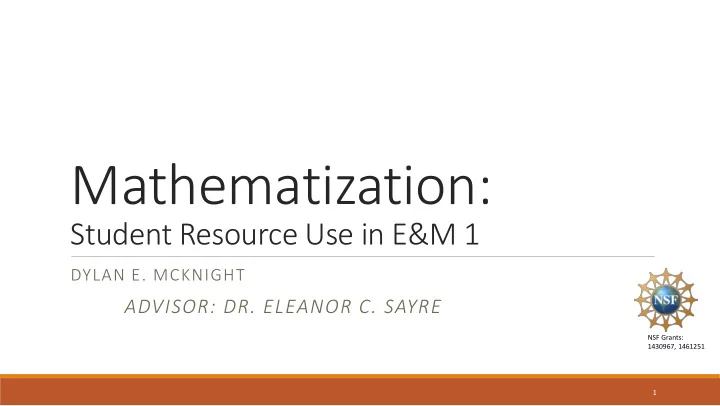

Mathematization: Student Resource Use in E&M 1 DYLAN E. MCKNIGHT ADVISOR: DR. ELEANOR C. SAYRE NSF Grants: 1430967, 1461251 1
Purpose Insight ◦ How upper division students think about the physical meaning of numbers. ◦ How to effectively teach complicated concepts such as the Taylor Series. 2
Resources Framework Resource: “Chunks of knowledge that students bring to bear on a situation.” 1 ◦ A Resource whose internal structure is explorable by the user is called a concept. 2 ◦ A Resource whose internal structure is no longer explorable is called a primitive. 2 1 K. Black and M. Wittmann, presented at the Physics Education Research Conference 2009, Ann Arbor, Michigan, 2009, WWW Document, (http://www.compadre.org/Repository/document/ServeFile.cfm?ID=9455&DocID=1327). 2 E. Sayre, M. Wittmann, and J. Donovan, presented at the Physics Education Research Conference 2006, Syracuse, New York, 2007, WWW Document, (http://www.compadre.org/Repository/document/ServeFile.cfm?ID=5234&DocID=2130). 3
Context Junior Level Electricity and Magnetism I 16 Students 4 groups of 4 students Groups collaborate to solve problems in class Taylor Series covered during weeks 3 and 4 4
Methodology Progressive Refinement of Hypotheses 3 generates Emergent Claims Video-based microanalysis of intra-group conversation Data is taken from 2 of the 4 groups 3 R. Engle, F. Conant, and J. Greeno, 2007 5
Tasks We observe students solving the following exercise: Find the Multipole Expansion for the potential for any localized charge distribution. Write your 1 𝑠 . answers in terms of powers of dV ’ 𝑒 𝑜 𝑔(𝑏) (𝑦−𝑏) 𝑜 ∞ The Taylor Series: 𝑔 𝑦 = 𝑜=0 r 𝑒𝑦 𝑜 𝑜! P α 1 𝑒𝑟 r’ The Potential Function: 𝑊 = 4𝜌𝜁 0 r 𝑠 O Original Image: Griffiths Introduction to Electrodynamics 4 th Ed. Figure 3.28 6
Solution Write r in terms of r and r’ using Law of Cosines. ◦ r 2 = r 2 + (r’) 2 – 2rr’cosα Factor a r 2 term out of the above expression. 2 𝑠 ′ 𝑠 ′ ◦ r 2 = 𝑠 2 (1 + − 2 𝑠 𝑑𝑝𝑡𝛽) 𝑠 dV ’ r 𝑠 ′ 𝑠 ′ Set r = 1 + 𝜗 , Where 𝜗 = ( 𝑠 )( 𝑠 − 2𝑑𝑝𝑡𝛽) P α ◦ r = 1 1 2 𝑠 (1 + 𝜗) − r’ r O Original Image: Griffiths Introduction to Electrodynamics 4 th Ed. Figure 3.28 7
Solution 1 1 2 with respect to ϵ . 𝑠 (1 + 𝜗) − Taylor Expand the expression 𝑒 𝑜 𝑔(𝑏) (𝑦−𝑏) 𝑜 ∞ The Taylor Series : 𝑔 𝑦 = 𝑜=0 𝑒𝑦 𝑜 𝑜! dV ’ r Determine a P ◦ a is related to the Potential as a function of r and r’. α ◦ Assuming, P is “far away,” 𝑠′ 𝑠 ≈ 0 , so we can take a = 0. r’ r ◦ 𝑔 𝜗 ≈ 1 𝑠 1 − 1 3 8 𝜗 2 O 2 𝜗 + Original Image: Griffiths Introduction to Electrodynamics 4 th Ed. Figure 3.28 8
Observations Students have to transform a from an arbitrary point to expand some function f(x) (Mathematics) to a value which has physical meaning (Physics). This is exceedingly difficult for the students. 9
Observations Highly dependent on Instructor framing: ◦ Instructor: It is generally true that a =0. ◦ Instructor : What should we pick for a ? Adam : 1 Ed : 0 Bill : -1 ◦ Directly after discussion the Instructor asks “what should a be?” Ed responds “0.” ◦ The Instructor asks “why should a be 0,” Ed responds “because we never pick anything else.” 10
Observations Students tend to rely heavily on prior experience when doing new Taylor Series. ◦ Ed : a was 0 here [Taylor Series quiz]. ◦ Jim : This [Multipole Expansion] is different but I don’t even understand what a is. ◦ Ed: I don’t particularly understand why a was 0 is that one [Taylor Series quiz] either. This suggests that the students are confused as to the physical meaning of a . 11
Explanation: A Resource Graph Observed students seem to have a thought process akin to: a 0 Point of Origin interest Location Far away Coordinates Contradiction Coordinates r = 0 r is large 12
Potential Further Questions When, Where, How should Taylor Series be presented in a Physics class and/or curriculum. What are effective teaching strategies for framing this such that students understand a better? Are there analogs to this in Chemistry and Engineering? ◦ If so, Where? ◦ Do they have similar or different resource graphs? 13
Recommend
More recommend